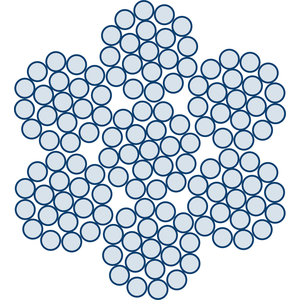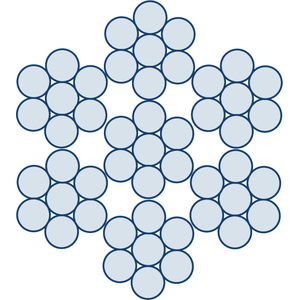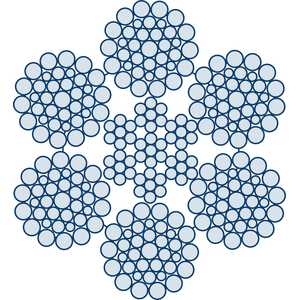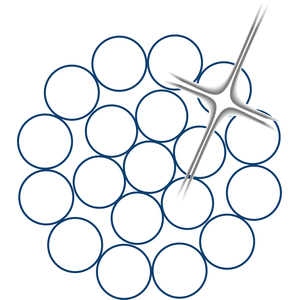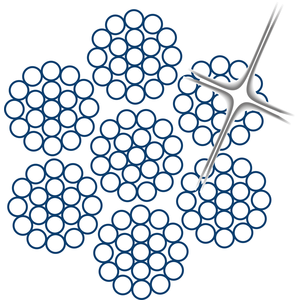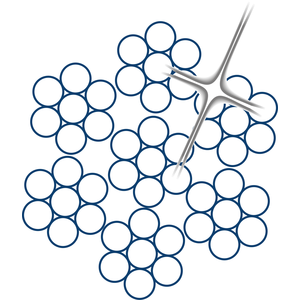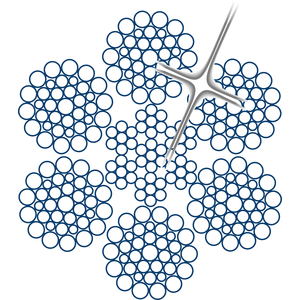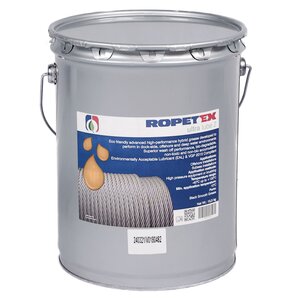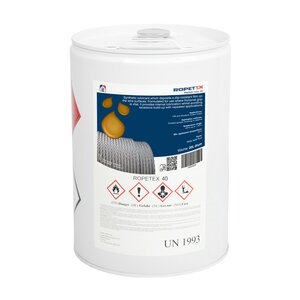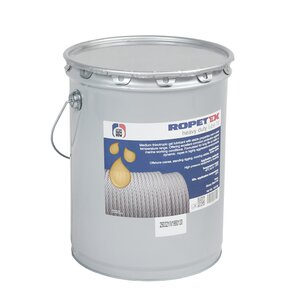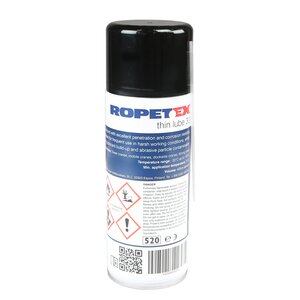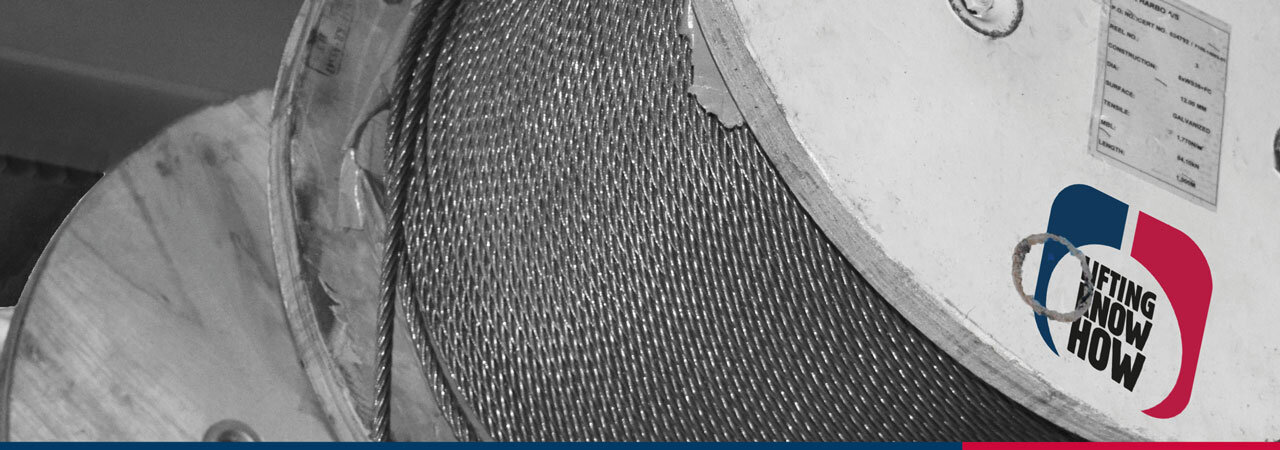
How to install your new steel wire rope
Install your new steel wire correctly for safe use and so as not to damage your product. Here you will find tips on how to unwind the steel wire from the packaging, advice on connection and running-in, and how to cut steel wire if necessary.
Proper handling of your steel wire is important so that you do not damage it during unpacking and installation. Read here our advice and instructions on how to unroll the wire from the packaging you have received it in, how to shorten or cut your steel wire rope, running in the steel wire rope and coupling between two steel wire ropes.
The procedure for installing the rope should be carried out in accordance with a detailed plan issued by the user of the steel wire rope. When releasing the outboard end of the rope from the supply reel or coil, this should be done in a controlled manner.
![]() On release of the bindings or the rope end fixing, the rope will want to straighten itself and unless controlled this can cause serious personal injury.
On release of the bindings or the rope end fixing, the rope will want to straighten itself and unless controlled this can cause serious personal injury.
Wire rope supplied on a coil
The coil of rope should be placed on the ground and rolled out straight, ensuring that it does not become contaminated with dust, grit, moisture or other harmful material.
The rope should never be pulled away from a stationary coil as this will induce turn into the rope and form kinks. If the coil is too large to physically handle it may need to be placed on a turntable which will allow the rope to be paid out as the end of the rope is pulled away from the coil.
Correct methods of paying out rope from a coil are shown in the video above.
Wire rope supplied on a reel
A shaft of adequate strength should be passed through the reel bore and the reel places in a suitable stand which allows it to rotate and be braked to avoid overrun during installation.
Where multi-layer coiling is involved the rope should be placed in equipment that has the capability of providing a back tension in the rope as it is being transferred from the supply reel to the drum. This is to ensure that the underlying laps of rope, particularly in the bottom layer, are wound tightly on the drum.
The supply reel should be positioned such that the fleet angle during installation is kept to a minimum. If a loop forms in the rope it should not be allowed to tighten to form a kink.
The reel stand should be mounted so as not to create a reverse bend during reeving, i.e. for a drum with an upper wind rope, take the rope off the top of the supply reel
![]() Note: The supply drum is not specifically designed for voltage spooling and may not be strong enough! If winding with voltage is required, the wire must be ordered on a drum that is strong enough for the purpose.
Note: The supply drum is not specifically designed for voltage spooling and may not be strong enough! If winding with voltage is required, the wire must be ordered on a drum that is strong enough for the purpose.
Otherwise, winding can be performed by hanging the wire drum up in a crane hook, the hook must be lowered max., A sufficient weight (2.5% -5% of the wire MBL) must be hooked, and the steel wire could be wound close to the drum
Coupling of steel wire ropes
If installing the new rope with the help of the old rope, one method is to fit a cable sock to each of the rope ends to be attached. The open end of the sock should be securely attached to the rope by a serving or alternatively by a suitable clip or with a welded eye.
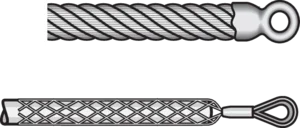
It is important to reduce the risk of turn being transmitted from the old rope into the new rope, especially when replacing rotation resistant ropes. This can be done by connecting the ropes with a fiber rope, alternatively the coupling or cable sock can be equipped with a swivel, which enables individual rotation between the ropes
![]() Note! We do not recommend connecting the new and the old rope by welding. This can cause turn to transmit from the old to the new rope and the welding can break, for example when passing through sheaves.
Note! We do not recommend connecting the new and the old rope by welding. This can cause turn to transmit from the old to the new rope and the welding can break, for example when passing through sheaves.
Alternatively, a length of fiber or steel rope of adequate strength may be reeved into the system for use as a pilot/messenger rope. If a steel wire rope is used, it should be a rotation resistant rope or have the same rope lay as the new rope .
![]() Note! The rope used as a coupling or pilot rope needs to have sufficient strength to withstand the new steel wire rope's own weight and any stress during installation.
Note! The rope used as a coupling or pilot rope needs to have sufficient strength to withstand the new steel wire rope's own weight and any stress during installation.
Cutting the wire rope
If it is necessary to cut the rope, secure servings should be applied on both sides of the cut mark. The length of each serving for a stranded rope should be at least equal to two rope diameters.
One serving either side of the cut mark is usually enough for preformed ropes (see EN 12385-2). For non-preformed ropes, rotation-resistant ropes and parallel-closed ropes a minimum of two servings each side of the cut mark is recommended.
Preferably, cutting of the rope should be done using a high-speed abrasive disc cutter. Other suitable mechanical or hydraulic shearing equipment may be used although not recommended when the rope end is to be welded or brazed. When cutting, ensure adequate ventilation to avoid any build-up of fumes from the rope and its constituent parts
![]() Note: Some special ropes contain synthetic material which, when heated to a temperature higher than normal production processing temperatures, will decompose and may give off toxic fumes.
Note: Some special ropes contain synthetic material which, when heated to a temperature higher than normal production processing temperatures, will decompose and may give off toxic fumes.
![]() Note: Rope produced from carbon steel wires in the form as shipped is not considered a health hazard. During subsequent processing (e.g. cutting, welding, grinding, cleaning) dust and fumes may be produced which contain elements that may affect exposed persons.
Note: Rope produced from carbon steel wires in the form as shipped is not considered a health hazard. During subsequent processing (e.g. cutting, welding, grinding, cleaning) dust and fumes may be produced which contain elements that may affect exposed persons.
After cutting, failure to correctly secure the rope end is likely to lead to slackness or distortions in the rope. An alternative method of cutting is by fusing and tapering, a process which is designed to prevent the wires and strands from unlaying.
Running in the new rope
To increase lifetime of your wire rope it is recommended to *run in* the new rope by operating the equipment slowly, preferably with a low load (i.e. 20% of the Working Load Limit (WLL)) for several operational cycles. This enables the new rope to adjust itself gradually to the working conditions. The rope should never 'run in' with full load or even with overload.
Check that the rope is spooling correctly on the drum and that no slack occurs in the rope or cross-laps of rope develops at the drum.
![]() Note: Irregular coiling will inevitably result in severe surface wear and rope distortion.
Note: Irregular coiling will inevitably result in severe surface wear and rope distortion.

 Do you have any questions?
Do you have any questions?
If you have any questions, please send us a message and we will be happy to help.
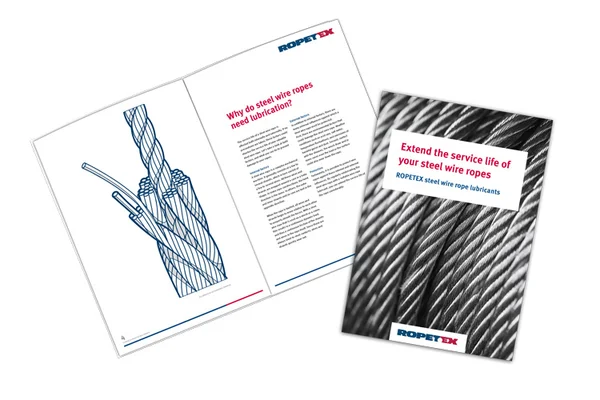
ROPETEX lubricants
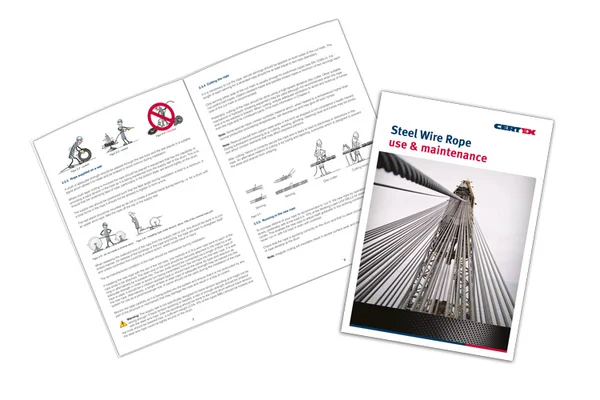
Steel wire rope use and maintenance
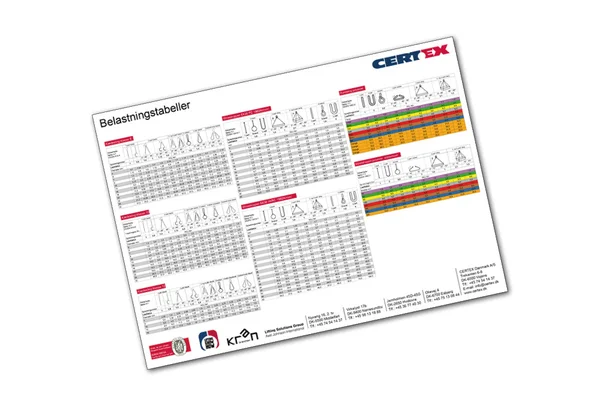
Load tables poster
Technical description of steel wire rope
Learn more about how a steel wire is constructed, the different cord part types and much else useful about steel wire.
How do I choose the correct steel wire rope?
What to consider when choosing your wire rope
Technical description of wire rope slings
Learn about length tolerances, dimensioning and a lot more




